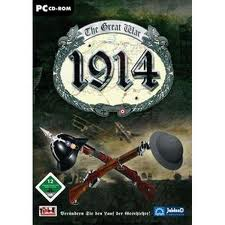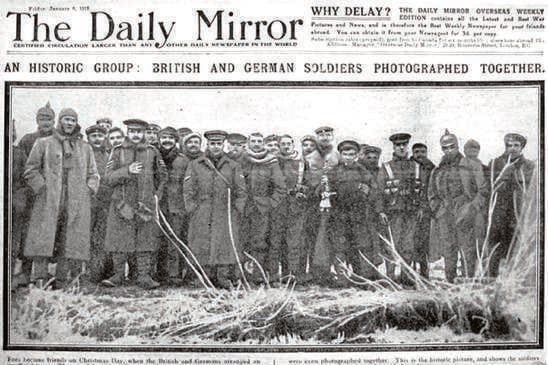The Christmas Truce of 1914: Abolish All Wars. Indict Today’s War Criminals in High Office
Under the Nuremberg Charter, wars of aggression are the ultimate crime: "The Crime against Peace". US and allied troops have a Duty to Disobey unlawful orders

The Spirit of Christmas in December 1914 prevailed:
“In the front lines, the
fraternisation of Christmas Eve is continued throughout the day; not all
units know about it, and it is not universal but is widespread over at
least half of the British front. Many bodies that have been lying out in
no man’s land are buried, some in joint burials. Many men record the
strange and wonderful events; may men exchange tokens or addresses with
German soldiers, many of whom speak English. 81 British soldiers die on
this day; a few die in areas that are otherwise peaceful and with
fraternisation going on, victims of alert snipers. In other areas, there
is considerable activity: 2nd Grenadier Guards suffer losses in a day
of heavy fighting. As night fell, things grew quiet as men fell back to
their trenches to take whatever Christmas meal that had been provided
for them.”
The Military High Command on both sides was firmly opposed to the Spirit of Christmas in the trenches. The Mot d’ordre of the French and British high command was to promote an “offensive spirit” in the trenches. In the words of General Sir Horace Smith-Dorrien, “Friendly intercourse with the enemy, unofficial armistices, however tempting and amusing they may be, are absolutely prohibited“:
Instructions were issued to commanders of all Divisions:
“such an attitude is however most dangerous for it discourages initiative in commanders and destroys the offensive spirit in all ranks…the
Corps Commander therefore directs Divisional Commanders to impress on
subordinate commanders the absolute necessity of encouraging offensive
spirit…”
Lessons of the 1914 Christmas Truce The military oath taken at the time of induction demands unbending support and allegiance to the US Constitution, while also demanding that US troops obey orders from their President and Commander in Chief Barack Obama:
“I,____________, do solemnly swear (or affirm) that I will support and defend the Constitution of the United States against all enemies, foreign and domestic; that I will bear true faith and allegiance to the same; and that I will obey the orders of the President of the United States and the orders of the officers appointed over me, according to the regulations and the Uniform Code of Military Justice. So help me God”Both president Donald Trump as well as his predecessor Barack Obama not to mention George W. Bush have blatantly violated all tenets of domestic and international law.
So that making an oath to “obey orders from the President” is tantamount to violating rather than defending the US Constitution.
“The fact that a person [e.g. Coalition troops] acted pursuant to order of his Government or of a superior does not relieve him from responsibility under international law, provided a moral choice was in fact possible to him.”Anti-war sentiment alone will not result in abolishing all wars.
An effective grass roots resistance against war requires a movement within the ranks of US-NATO Armed Forces to disobey orders. That is the message of the 1914 Christmas Truce. Lay down your arms, disobey orders emanating from wars criminal in high office.
In France, an unconfirmed report suggests that soldiers and war veterans are joining the Yellow Vests.

And once a movement of members of the Armed Forces of all ranks integrates a civilian grassroots protest movement , with soldiers refusing to fight, the US-NATO military agenda will be in shatters.
The issue of war propaganda must also be addressed including the indoctrination of those serving in the Armed Forces. The official US-NATO motto is: Going after the bad guys, waging a “Global War on Terrorism” against so-called “jihadists”.
Without the gush of daily (corporate) media disinformation which upholds US-NATO led wars as humanitarian endeavours under the banner of “Responsibility to Protect”, the war-makers in high office would have no leg to stand on.
Within the corporate media, journalists also have the choice to “disobey orders” and many of them are doing so, as well as joining the ranks of the independent media.
This is the spirit of Christmas which we wish to uphold, based on the Lessons of the Christmas Truce of December 25, 1914.
May Peace and the Spirit of Christmas prevail!
Abolish All Wars! indict the War Criminal in high Office.
Restore sanity in international diplomacy.
Michel Chossudovsky, Global Research, December 25, 2018
The Christmas Truce of 1914
by 1914-1918.net
The Christmas Truce has become an enduring image of the triumph of man’s spirit over adversity. What really happened in no man’s land between British and German infantry in December 1914, and who was there?Once the fighting of the First Battle of Ypres died down in November 1914, British units that had been holding the Ypres Salient were relieved by French ones. By December, the BEF had moved and was now holding a continuous sector of the Western Front from a little south of St Eloi, round past Armentières to Neuve Chapelle, past Festubert and to the La Bassée Canal at Givenchy.
The British force in France now consisted of the shattered units of the regular army, most of which had been all but destroyed at Ypres and which were in the process of being rebuilt by receiving new drafts, with the welcome addition of two Divisions making up the Indian Corps and some units of the Territorial Force.
The position being held consisted of crude trenches and breastworks. The weather had been continuously wet for some time, and conditions were particularly trying.
The static and dull nature of trench warfare and the close proximity of the enemy (which meant that they could be heard, and their breakfast cooking smelled, although rarely seen) caused many men to be curious about the men they were facing. They were certainly facing the same conditions of wet and cold, and in a strange way a mutual respect developed.
There were occasional shouted conversations between trenches, and the odd instance of exchange of goods, although to be too adventurous was foolhardy for men were continually lost to sniper fire.
Build up to the truce
Under strong French pressure to take the initiative, the army was ordered into a series of small piecemeal attacks that proved to be very costly. Cut down by rifle and machine gun fire and unable to enter enemy trenches, the attacking units left many casualties lying in no man’s land and on the enemy barbed wire defences.5 December 1914
II Corps HQ [General Sir Horace Smith-Dorrien] issued an instruction to commanders of all Divisions:
“It is during this period that the greatest danger to the morale of troops exists. Experience of this and of every other war proves undoubtedly that troops in trenches in close proximity to the enemy slide very easily, if permitted to do so, into a “live and let live” theory of life…officers and men sink into a military lethargy from which it is difficult to arouse them when the moment for great sacrifices again arises…the attitude of our troops can be readily understood and to a certain extent commands sympathy…such an attitude is however most dangerous for it discourages initiative in commanders and destroys the offensive spirit in all ranks…the Corps Commander therefore directs Divisional Commanders to impress on subordinate commanders the absolute necessity of encouraging offensive spirit… friendly intercourse with the enemy, unofficial armistices, however tempting and amusing they may be, are absolutely prohibited”The early weeks of December 1914
Tremendous volumes of mail and gifts for the troops were sent from homes in the United Kingdom and Germany. King George V sent a Christmas card to every soldier, sailor and nurse; the Princess Mary fund despatched a gift box to every serving soldier.
14 December 1914
An attack of 8th Brigade at Wytschaete on 14 December 1914 fails with heavy casualties. 18 December 1914An attack by 22nd Brigade [2nd Queen’s and 2nd Royal Warwickshire] on the Well Farm position at La Boutillerie fails with heavy casualties.
A further effort [by 20th Brigade; 2nd Scots Guards and 2nd Border] later in the day also fails.19 December 1914An attack by 11th Brigade [1st Somerset Light Infantry, 1st Hampshire and 1st Rifle Brigade] on the “German Birdcage” east of Ploegsteert Wood fails with heavy casualties, many of which are caused by British heavy artillery firing short of target.
20 December 1914
Local truce on the front of 22nd Brigade; Germans begin by taking in British wounded from no man’s land. There is some contact: according to Lt G. Heinekey of 2nd Queen’s, it lasted all morning. Lt Henry Bower, 1st South Staffordshire and at least one soldier of the 2nd Queen’s were killed by rifle fire from neighbouring units while assisting with the wounded. A similar activity took place on the front of 20th Brigade.
23 December 1914
A German soldier, Karl Aldag, reports that both sides had been heard singing hymns in the trenches. German troops coming into the lines bring Christmas trees. Some men begin to place them on the parapets of the fire trenches. Local truce on the front of 23rd Brigade.
24 December 1914, Christmas Eve
The weather changes to a hard frost. This makes trench conditions a little more bearable. 98 British soldiers die on this day, many are victims of sniper fire.
A German aeroplane drops a bomb on Dover: the first air raid in British history. During the afternoon and early evening, British infantry are astonished to see many Christmas trees with candles and paper lanterns, on enemy parapets.
There is much singing of carols, hymns and popular songs, and a gradual exchange of communication and even meetings in some areas. Many of these meetings are to arrange collection of bodies. In other places, firing continues. Battalion officers are uncertain how to react; in general they maintain precautions.
The night brings a clear, still air with a hard frost. British and German troops fraternise at Christmas 1914

25 December 1914, Christmas Day
Men of 20th Brigade bury their dead of the attack of 18 December, alongside German soldiers engaged in the same activity. Christmas Day, 1914.Units behind the lines attend church services and have in most cases arranged Christmas dinners which are taken in barns and shattered buildings.
In the front lines, the fraternisation of Christmas Eve is continued throughout the day; not all units know about it, and it is not universal but is widespread over at least half of the British front. Many bodies that have been lying out in no man’s land are buried, some in joint burials. Many men record the strange and wonderful events; may men exchange tokens or addresses with German soldiers, many of whom speak English.
81 British soldiers die on this day; a few die in areas that are otherwise peaceful and with fraternisation going on, victims of alert snipers. In other areas, there is considerable activity: 2nd Grenadier Guards suffer losses in a day of heavy fighting. As night fell, things grew quiet as men fell back to their trenches to take whatever Christmas meal that had been provided for them.
Some snow. In some areas, the friendly spirit was resumed. Gradually
however, officers and men on both sides began to resume normal trench
caution. The atmosphere in general remained relaxed as Brigade and
Battalion officers took a pragmatic view of events. The chance was taken
to carry out work that would otherwise have been hazardous. By now,
however, news of the truce was reaching higher commands. General Sir
Horace Smith-Dorrien requested particulars of those units and officers
who took part, with a view to disciplinary action. In the event, no
action was taken against any unit or officer. 62 British soldiers die on
this day.
27-31 December 1914
The weather turns wet again, with rain, sleet and storms. There were instances of men disappearing in the flooded trenches. Yet in some areas the friendly mood remained for several days and there was almost no firing, although open fraternisation gradually died away. On New Years Eve, there was a certain amount of singing and exchange of messages, but no truce as such.
27-31 December 1914
The weather turns wet again, with rain, sleet and storms. There were instances of men disappearing in the flooded trenches. Yet in some areas the friendly mood remained for several days and there was almost no firing, although open fraternisation gradually died away. On New Years Eve, there was a certain amount of singing and exchange of messages, but no truce as such.
BBC Video on the Christmas 1914 Truce
British units which took part in the truce
Note: those units that were under command of the Divisions and
Brigades shown but do not appear in the table did not take part in
fraternisation, often because they were in billets and out of the front
line at the time. The list has been compiled by reference to war
diaries, soldiers letters, reports, etc.
| Brigade | Unit |
| 5th Division on Wulverghem – Messines road and in the River Douve valley | |
| 14th Brigade | 1st Devonshire |
| 1st East Surrey | |
| 2nd Manchester | |
| 15th Brigade | 1/6th Cheshire |
| 1st Norfolk | |
| 4th Division in front of Ploegsteert Wood | |
| 10th Brigade | 1st Royal Warwickshire |
| 2nd Royal Dublin Fusiliers | |
| 2nd Seaforth Highlanders | |
| 1st Royal Irish Fusiliers | |
| 11th Brigade | 1st Hampshire |
| 1st Rifle Brigade | |
| 1st East Lancashire | |
| 1/5th London (London Rifle Brigade) | |
| 12th Brigade | 2nd Lancashire Fusiliers |
| 2nd Essex | |
| 1/2nd Monmouthshire | |
| XXXIII Bde RFA | 135 Battery RFA |
| 31 Heavy Battery RGA | |
| 6th Division at Frelinghien and Houplines | |
| 16th Brigade | 1st Leicestershire |
| 1st Buffs (East Kent) | |
| 17th Brigade | 2nd Leinster |
| 3rd Rifle Brigade | |
| 1/16th London (Queen’s Westminster Rifles) | |
| 1st North Staffordshire | |
| 19th Brigade | 2nd Royal Welsh Fusiliers |
| 2nd Argyll and Sutherland Highlanders | |
| 1/5th Cameronians (Scottish Rifles) | |
| XXXVIII Bde RFA | 24 Battery RFA |
| XIII (H) Bde RFA | 87 Battery RFA |
| 7th Division at Bois Grenier, La Boutillerie and on the Fromelles road | |
| 20th Brigade | 2nd Border |
| 2nd Gordon Highlanders | |
| 1/6th Gordon Highlanders | |
| 2nd Scots Guards | |
| 21st Brigade | 2nd Wiltshire |
| 2nd Bedfordshire | |
| 2nd Yorkshire | |
| 22nd Brigade | 2nd Queen’s (Royal West Surrey) |
| 1/8th Royal Scots | |
| XXIII Bde RFA | 104 Battery RFA |
| XIV Bde RFA | F and T Batteries RHA |
| III Heavy Bde RGA | 111 and 112 Batteries RGA |
| A and B Squadrons, the Northumberland Hussars | |
| 8th Division at Picantin, Fauquissart and Neuve Chapelle | |
| 23rd Brigade | 2nd Devonshire |
| 2nd Cameronians (Scottish Rifles) | |
| 24th Brigade | 2nd East Lancashire |
| 2nd Northamptonshire | |
| 25th Brigade | 1/13th London (Kensington) |
| 1st Royal Irish Rifles > War diary from Christmas 1914 | |
| XLV Bde RFA | 5 Battery RFA |
| 2 Field Company, the Royal Engineers | |
| Meerut Division at Richebourg l’Avoué | |
| Gharwal Brigade | 1/39 Gharwal Rifles |
| 2/39 Gharwal Rifles | |
| 18th Hussars | |
German units which took part in the truce
| Brigade | Unit |
| 6th Bavarian Reserve Division, facing Kemmel | |
| 12th Bavarian Reserve Brigade | 17th Bavarian Reserve Regiment |
| 40th Division, facing Wulverghem and Ploegsteert Wood and at Frelinghien | |
| 48th Brigade | 10th Infantry Regiment |
| 88th Brigade | 104th Infantry Regiment |
| 6th Jaeger Battalion | |
| 89th Brigade | 133rd Infantry Regiment Saxon |
| 134th Infantry Regiment | |
| 24th Division, on the Armentieres-Lille railway | |
| 47th Brigade | 179th Infantry Regiment |
| 48th Brigade | 107th Infantry Regiment |
| 13th Division, at Fromelles and on Rue des Bois Blancs | |
| 25th Brigade | 158th Infantry Regiment |
| 13th Infantry Regiment | |
| 11th Jaeger Battalion | |
| 26th Brigade | 55th Infantry Regiment |
| 15th Infantry Regiment | |
| 14th Division, at Aubers and Festubert | |
| 27th Brigade | 16th Infantry Regiment (3rd Westphalian) |
The original source of this article is 1914-1918.net
Copyright © Prof Michel Chossudovsky, 1914-1918.net, 2018
Comment on Global Research Articles on our Facebook page
Become a Member of Global Research
No comments:
Post a Comment